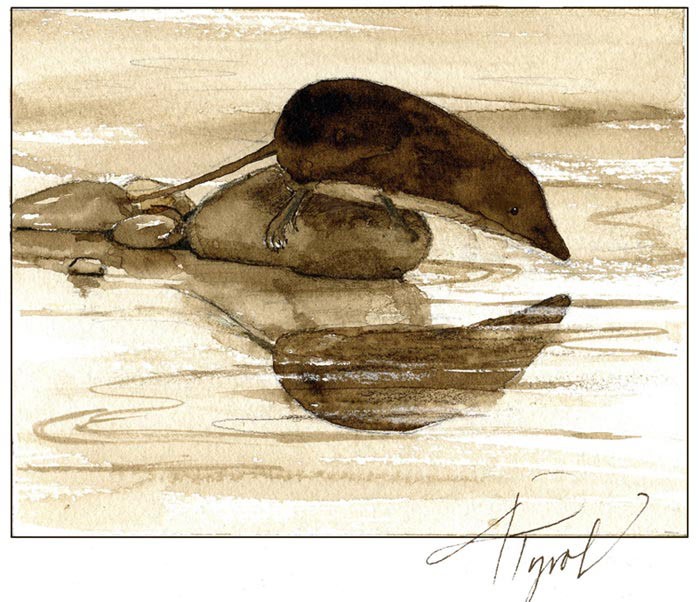
On a morning walk around the pond, the dog and I encountered a dead shrew – perhaps the unfortunate casualty of a neighborhood feline or a red fox (shrews are well-known for being distasteful to mammalian predators). When I picked it up and noticed its velvety black fur, long tail, and unusually large hind feet, I realized that this was a species I did not recognize. I tossed it on the passenger seat of the car so I could identify it later at work.
Like all shrews, this small, mouse-like mammal lying on my desk had a long pointed snout and tiny eyes. Its minuscule ears were barely visible, covered by short velvety fur. As I stroked the soft black hair, I noticed that the fur offered little resistance no matter which direction my finger passed over it, a perfect adaptation for life underground, permitting the animal to slide easily through a tight tunnel in any direction.
After taking a few measurements and consulting my two favorite small mammal references, I identified it as a Northern Water Shrew. In addition to its large hind feet and long tail (the longest of all Vermont shrews), the feature that separated this species from other similar long-tailed shrews was the presence of stiff hairs on the edges of its hind feet.
Examining the specimen more closely, I soon realized that the hairs were not just confined to the back feet, as my references indicated. The front feet and all the toes were edged with this fringe of stiff hairs as well. When I gently pushed the tip of my finger into the palm of one foot, the hairs spread out, making it easy to see how they would assist in paddling through the water.
As their name implies, Northern Water Shrews are rarely found far from water. Their Latin name, Sorex palustris, reflects this habitat preference as well, and literally means, “the shrew that dwells in marshes.” They seem to be found most often near swift-flowing streams with overhanging banks and an abundance of rocks and logs. They can also be found in swamps, beaver meadows, and even moist forested uplands with moss-covered rocks and boulders.
Although it’s obvious how “flippers” might help water shrews hunt insects, small fish, and other aquatic animals, I wondered why they evolved hairs, rather than webbing like otters or beavers. Since water shrews also spend a lot of time underground, perhaps hairs are more functional than webbing on dry land. Or, as I learned by reading a few pages in Wild Mammals of New England, by Alfred Godin, the hairs may help shrews walk on the water as well as swim in it.
Several observers have seen water shrews run or “skate” across the water’s surface for more than five feet at a stretch. Some biologists suggest that air bubbles get trapped in the hairs, enabling the shrew to remain on the surface. This water-walking ability could be helpful when avoiding predators, chasing prey, or perhaps just showing off to curious naturalists.
Like all shrews, water shrews remain active during the winter months. Shrews have extremely high metabolic rates, which require that they consume close to their own weight in food each day. Since they don’t have the ability to store significant body fat, they can starve after just a few hours without food. Most observations of water shrews in winter have been made along streams, where they utilize a space that is created beneath shelf ice that forms above streams. As water levels drop, these shrews can travel along stream banks foraging for aquatic insects, larvae, and fish with a roof over their head. They also spend time in tunnels beneath the snow and underground, where temperatures are more stable.
Apparently secure in New Hampshire, the Northern Water Shrew is considered rare in Vermont, where it is listed as a High Priority Species of Greatest Conservation Need. However, its distribution and population status are unclear, perhaps due to the animal’s secretive nature. Consider, for example, the results from an intensive study of small mammal distribution in Vermont, undertaken in the 1990s by University of Vermont graduate student Rich Chipman. During his field work, Rich managed to trap just one water shrew, as compared to 99 short-tailed shrews. Historical trapping results for these two species seem consistent with Chapman’s experience. While examining museum collections, Alfred Godin discovered a total of 92 New England water shrew specimens, compared to 633 for the ubiquitous short-tailed shrew.
Understanding the rarity of Northern Water Shrew sightings not only made my discovery a little more interesting, but also of more value to the scientific community. To ensure that the shrew’s life was not in vain, I completed out a Rare Animal Occurrence Report Form and sent it off to the Vermont Wildlife Diversity Program.


Discussion *